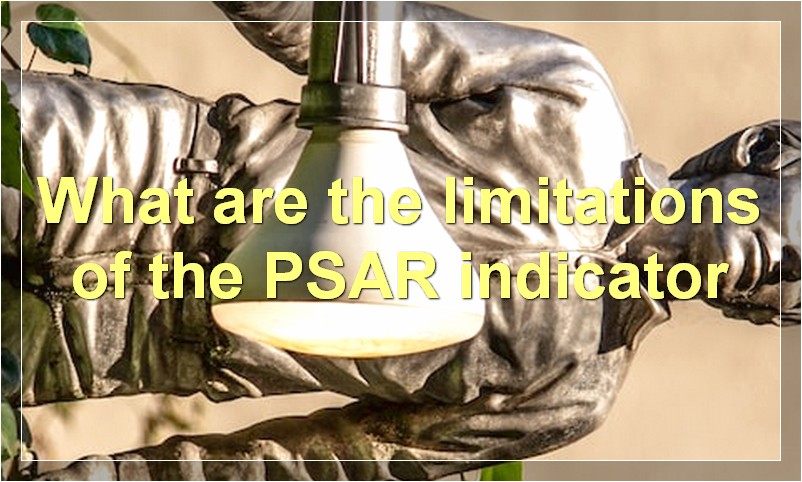The PSAR indicator is an important tool for traders to understand and use. This article will provide readers with key information on how to use the PSAR indicator for trading, including its key components and how to buy and sell.
What is the PSAR indicator
The PSAR indicator is a technical indicator used by traders to identify potential reversals in the market. The PSAR stands for Parabolic Stop and Reverse, and is a trend-following indicator. The PSAR indicator is created by plotting two lines on a price chart, the stop line and the reverse line. The stop line is determined by the highest high of the previous candles, and the reverse line is determined by the lowest low of the previous candles. When the price of an asset breaks below the stop line, it is considered a bearish signal, and when the price breaks above the reverse line, it is considered a bullish signal.
How is the PSAR indicator used in trading

The PSAR indicator is used to set and trail stop-losses for both long and short positions. It is based on the concept of parabolic time/price systems.
When the PSAR indicator is below the price, it indicates a bullish trend, and when it is above the price, it indicates a bearish trend. The PSAR indicator can be used to set trailing stop-losses by finding the most recent swing high or swing low and placing the stop-loss at the corresponding PSAR level.
For example, if you are in a long position and the PSAR indicator is below the price, you would trail your stop-loss at the most recent swing high. If the price then falls and the PSAR indicator rises above the price, it would trigger your stop-loss and you would exit the trade.
The PSAR indicator can also be used to confirm trend reversals. For example, if the PSAR indicator is above the price and the price makes a new high, it is likely that a reversal is occurring and you should exit your trade.
What are the key components of the PSAR indicator
The PSAR indicator is a technical tool used by traders to identify potential reversals in the market. The indicator is composed of three key components:
1. The Parabolic SAR (Stop and Reverse)
2. The Acceleration Factor
3. The Maximum Acceleration Level
The PSAR indicator is calculated using the following formula: PSAR = Prior SAR + AF x (EP – Prior SAR)
Where:
PSAR = The current value of the PSAR indicator
Prior SAR = The value of the PSAR indicator from the previous period
AF = The acceleration factor
EP = The extreme point (high or low) from the previous period
The Parabolic SAR is the core component of the PSAR indicator and is used to identify potential reversals in the market. The SAR is calculated using the extreme points ( highs and lows) from prior periods and the acceleration factor. The acceleration factor is used to increase or decrease the speed at which the SAR moves. The maximum acceleration level is the highest level that the AF can reach.
How does the PSAR indicator generate buy and sell signals
The Parabolic SAR (PSAR) indicator is a technical tool that is used to identify potential reversals in price trends. The PSAR indicator is calculated using a formula that takes into account the price of the security, the time period, and the volatility. The indicator generates buy and sell signals based on the direction of the price trend. If the price is trending upwards, the indicator will generate a buy signal. If the price is trending downwards, the indicator will generate a sell signal.
What are the benefits of using the PSAR indicator
The PSAR indicator is a momentum indicator that is used to measure the price direction of an asset. The indicator is composed of two moving averages, one slow and one fast, which are used to generate buy and sell signals. The PSAR indicator is also used to confirm other technical indicators, such as support and resistance levels.
The main benefit of using the PSAR indicator is that it can help traders to make more informed decisions about when to enter and exit trades. The indicator can also be used to confirm other technical indicators, providing an extra layer of confirmation for trade signals.
What are the limitations of the PSAR indicator

There are a few limitations to the PSAR indicator which include:
1) The PSAR indicator is lagging, meaning it will usually provide signals after the move has already begun.
2) The indicator is also prone to false signals, particularly in choppy markets.
3) Like most indicators, the PSAR can give conflicting signals in different timeframes. This means that traders need to be aware of the overall market conditions before taking a trade.
Despite these limitations, the PSAR indicator can still be a useful tool for traders if used correctly. For example, many traders use the indicator in conjunction with other technical indicators or price action setups to confirm signals.
How can the PSAR indicator be improved
The PSAR indicator can be improved by using different methods to calculate it. One way is to use a different moving average, such as the exponential moving average, instead of the simple moving average. Another way is to use a different time frame, such as a longer or shorter time frame, to calculate the PSAR. Finally, the PSAR indicator can be improved by using different values for the stop-loss and take-profit levels.
What are some alternative indicators to the PSAR indicator
The PSAR indicator is a popular tool among traders, but it is not the only option available. Here are some other indicators that can be used to make trading decisions:
The MACD indicator is a momentum indicator that can help identify trend reversals.
The RSI indicator is a momentum indicator that can help identify overbought and oversold conditions.
The Bollinger Bands indicator is a volatility indicator that can help identify periods of high and low volatility.
The Ichimoku Cloud indicator is a overall market trend indicator that can help identify the direction of the market.
How has the PSAR indicator performed in backtesting
The PSAR indicator is a technical indicator that is used to identify potential reversals in the price of a security. The indicator is calculated by taking the highest high and lowest low of the past few periods and plotting them on a graph. When the price of a security reaches either the highest high or lowest low, it is considered to be at a potential reversal point. The PSAR indicator can be used in backtesting to identify potential reversals in the price of a security.
Is the PSAR indicator suitable for all markets and timeframes
The PSAR indicator is a technical indicator that is used to identify potential reversals in the price of an asset. It is suitable for use in all markets and timeframes.

